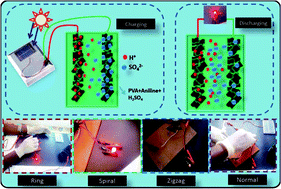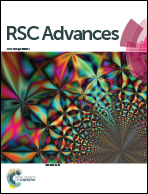Nitrogen-doped reduced graphene oxide and aniline based redox additive electrolyte for a flexible supercapacitor†
Abstract
Nitrogen-doped reduced graphene oxide (N-rGO) with a layered structure was prepared by a simple hydrothermal method. Structural and elemental analysis revealed the successful doping of N atoms into the carbon sites of graphene. The presence of wrinkles and folds in the transmission electron microscope images provided evidence for the excellent flexibility of the prepared N-rGO. Additionally, the curved edges further illustrated the implantation of N atoms in the carbon sites of graphene. The unreduced oxygen functional groups and N atoms provided additional pseudocapacitance to the N-rGO. The flexible N-rGO fiber supercapacitor exhibited a 5.7 times higher specific capacitance with the aniline additive than without the additive. The maximum specific capacitance was 2.02 F m−1 at 5 mV s−1. Finally, a serially connected device was integrated with a commercially available solar cell and used to power a light emitting diode in different flexible modes, after charging up to 2.2 V. All these results demonstrate that the fabricated device can be a suitable energy storage device for various flexible energy storage applications.


 Please wait while we load your content...
Please wait while we load your content...